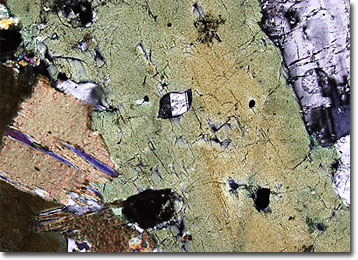Polarized Light Microscopy Digital Image Gallery
Tonalite
Tonalite was first described from Monte Adamello near Tonale in the Eastern Alps, which is the origin of its name. The intrusive igneous rock is often a chief component of extensive batholiths, such as the Shasta Valley batholith of California.

Sometimes alternatively referred to as quartz diorite, tonalite is typically comprised of plagioclase feldpar, alkali feldspar, and more than 20 percent quartz. In addition, accessory minerals that are often present in the rock include pyroxenes and amphiboles. Coarse-grained, tonalite is somewhat like granite in appearance, but is often darker in color. Some specimens, however, exhibit what is usually termed "salt and pepper" coloration, consisting of a black and white dappled pattern. A type of tonalite in which biotite is the sole mafic mineral present is sometimes known as trondhjemite. Significant occurrences of tonalite can be found in Alaska, Scotland, Ireland and various other locales around the world.
